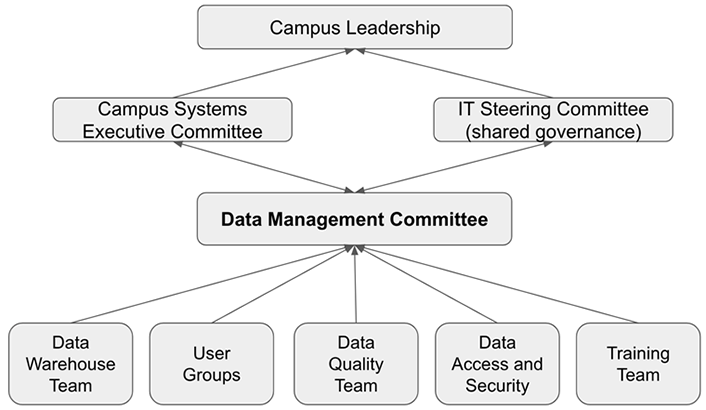Ten years ago, UMBC embarked on a journey to standardize institutional data and cultivate new ways of understanding and using data to serve the entire campus community.

When discussing the development of our data warehouse and our university's journey since then, I often think about author and astronomer Clifford Stoll's quote: "Data is not information, information is not knowledge, knowledge is not understanding, understanding is not wisdom." Back in 2010, University of Maryland, Baltimore County (UMBC) was facing a very common dilemma. We had a lot of data that we were accumulating around various systems, and we needed ways to add context to that data. This was our first step down the critical path we wanted to travel from data toward wisdom.
To start our journey, we did what many did and created a data warehouse to hold our data so we could start to provide information, then gain knowledge, and hopefully become wiser from that knowledge. We did this with one overarching principle: all data in the warehouse belongs to the university. Data sources must be fully integrated into the warehouse, not restricted to individual groups or owners that could control the use of and access to that data. Every data set would provide the institution with a deeper understanding of our campus community and would help us move along that path toward wisdom. To this end, our IT division worked closely with leadership across the institution. We leveraged partnerships with Institutional Research, Enrollment Management, and other key stakeholders, stressing the importance of having a single source of truth and the need for unified governance to engender trust and transparency from the outset.
Designing centralized governance into the warehouse from its inception was not a popular decision with all involved. In many cases, both academic and administrative units pushed back on the idea that other groups could see "their" data. In an effort to build confidence on campus and among all stakeholders that we were being transparent about the process, we established a clear governance structure anchored by a data management committee that met each semester. This governance group contained representatives from the leadership of each college and division and had several subcommittees responsible for key areas, as illustrated in figure 1.

This Data Management Committee reported to our administrative oversight group, as well as to our campus shared governance structure, and directly to campus leaders through these two mechanisms. It is important to note that several iterations of these structures were needed before we had any true success. Our first attempt placed too much on the shoulders of the main committee, leaving the group overburdened and unable to dedicate the resources needed. Our next attempt used the structure in figure 1, with a number of subject-matter experts for the detailed work on the subcommittees. The Data Management Committee could then focus on providing strategic guidance and oversight without being overloaded with highly detailed and nuanced tasks.
This approach was successful in large part because of two factors. First was our ability to provide a level of reporting that didn't exist on our campus before the warehouse. This allowed us to illustrate to data owners and managers new tools and new methods of data analysis unavailable to them previously. The second key factor was leadership's drive to become more of a data-driven institution. As part of this, they recognized the need for a single source of data, and they were willing to help champion this cause. Our provost and head of enrollment management were vocal partners, using the information gathered from the data in their departmental and division meetings. We shifted from accepting anecdotes and stories about data and trends to requiring that contextualized data was presented to back up a supposition. This shift in thinking helped UMBC move further along our journey from processing information to approaching a more knowledgeable stage and a deepening understanding of our community.
As we worked to build a unified data repository, we never required any group to integrate their data into our warehouse. Instead, we conducted extensive outreach as part of a communications plan to the campus about the data warehouse. UMBC has a wonderful collaborative spirit, and our team, along with teams from institutional research and other groups working in the warehouse, helped new groups comprehend how adding their data to the warehouse would help them in their own journey to understand their data and use it wisely in their planning.
Over the next several years, we continued to bring in more and more data sources. At some point, this process shifted from us approaching groups to try to convince them to include their data, to different groups approaching us to integrate their data so they could gain insights from all the different aspects that exist in the warehouse. This shift created a culture and philosophy at UMBC in which the expectation is for data to be available and easily accessed.
As the warehouse matured, we brought in dozens of data sources—at last count we had more than 45—and the user community became more fluent with accessing the data in meaningful ways. We began to look at how we could impact student success through this work. All of this was done with guidance from our governance groups to ensure we were making choices in line with our institutional principles and priorities. Then something truly unique happened—we experienced a major disruption this spring with the quick shift to remote learning, prompting a need for new types of data analysis as we looked to reopen the campus in a safe and effective manner.
As we looked toward the fall 2020 semester, the university was facing a staggering number of unknowns and uncertainties. Our data warehouse team quickly integrated new types of data into the warehouse, including Wi-Fi location data, license-plate readers, card access logs, COVID symptom tracking reports, COVID case reports, and testing results. These new data sources changed both the makeup of the warehouse and the intimacy of the data we were now able to cross-reference on an individual—actions could now be taken not just on students’ schedules but based on a their movements and reported symptoms, bringing a renewed concern about privacy to the forefront.
This is where wisdom, and the understanding of what we didn't know, played a central role for UMBC. Our existing governance structure doesn't have a group focused on user privacy. We realized during this transition that we had begun granting access without sufficiently clear guidance on responsibilities for some of the new data within the warehouse. We were forced to rethink our approach and determine how to use the knowledge that the data warehouse provides in a fashion that is consistent with our shared values.
At the same time, UMBC is currently developing a learning records store. This data repository looks at highly detailed and specific information on student behavior, tendencies, and other measures to help improve student success. We know that privacy needs to be at the core of that initiative, just like we understood the importance of governance and transparency when creating our data warehouse. How do our governance structures need to adapt for the differences in a learning records store and an evolving data warehouse? How do legal considerations such as GDPR and new local privacy laws that are on the horizon influence and guide not just our usage of the data but our data lineage, and what impacts will that have?
Over the next year, with the new reach of the data warehouse and the establishment of the learning records store, we need to remain intentional in two critical aspects. Governance must continue to play a central role in these initiatives, and it must evolve while maintaining the principles of the institution. Second, we cannot take for granted that the move toward wisdom is a one-way journey. We need to be open minded and humble, recognizing that as we continue to add data, we may need to step back and reconsider where we are on that journey. New data and new information might move us backwards for a time, but it should also position us to then move farther toward wisdom than would have been possible without taking the step back. We need to ask the difficult questions about our decision-making processes and make sure we continue our journey to a data informed institution while recognizing that, as our president, Freeman Hrabowski, is so fond of saying, success is never final.
For more on enterprise IT issues and leadership perspectives in higher education, please visit the EDUCAUSE Review Enterprise Connections blog as well as the Enterprise IT Program web page.
Damian Doyle is the Associate Vice President, Enterprise Infrastructure Service for the Division of IT at University of Maryland, Baltimore County.
Kevin Joseph is the Senior Director, Business Intelligence for the Division of IT at University of Maryland, Baltimore County.
© 2020 Damian Doyle and Kevin Joseph. The text of this work is licensed under a Creative Commons BY-SA 4.0 International License.
